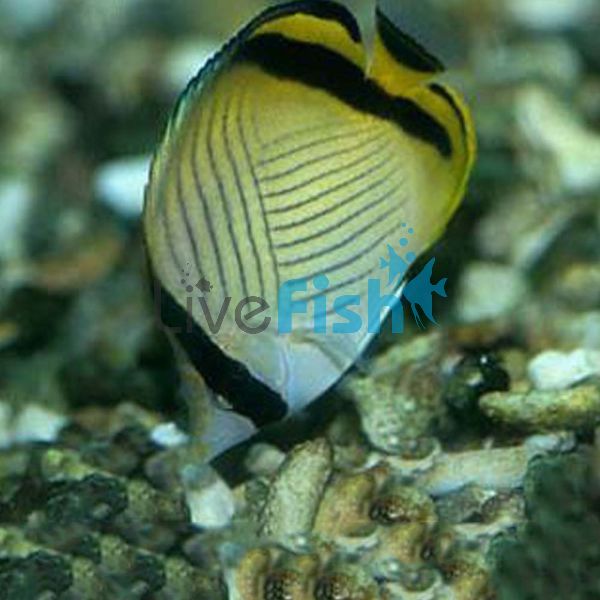Vagabond Butterflyfish - Medium
The Vagabond Butterflyfish has an assortment of bright colors. Its body is bright white at the front and yellow at the rear. The tail fin, dorsal fin, and anal fin are also yellow. Diagonal lines cover the body and run from the top and bottom of the body towards the front of the fish. A dark bar runs vertically over the eye, and another bar runs vertically down the rear of the fish's body. The dorsal and anal fins have a blue trim, and the tail fin has black trim and a black line running through it.
Butterfly Fish - Vagabond
The Vagabond Butterflyfish has an assortment of bright colors. Its body is bright white at the front and yellow at the rear. The tail fin, dorsal fin, and anal fin are also yellow. Diagonal lines cover the body and run from the top and bottom of the body towards the front of the fish. A dark bar runs vertically over the eye, and another bar runs vertically down the rear of the fish's body. The dorsal and anal fins have a blue trim, and the tail fin has black trim and a black line running through it.
Butterflyfish form distinct, lifelong mating pairs, that jointly defend their feeding territory. In the wild, they are oviparous, pelagic spawners. There are no reports of successful breeding in captivity.
The natural habitat of the Vagabond Butterflyfish is in the Indo-Pacific area. It can be found on the East African coast, South Africa, Southern Japan, and Polynesia. It inhabits reef flats, outer reef slopes, and lagoons between 5-30 meters.
Tank Recommendations for your Vagabond Butterflyfish
The smallest recommended tank size is 100 gallons (378.5 liters).
Vagabond Butterflyfish are not reef safe. They will eat anemones, coral polyps, and invertebrates. A suitable tank should be established with plenty of algae growth.
There should be live rock and other rockwork and rubble. it needs to be arranged to create plenty of hiding places. These are active fish so there should also be plenty of open water for swimming. The substrate should be a mixture of sand and coral.
Suitable Tank Buddies
The Vagabond Butterflyfish is peaceful and doesn't show aggression to other species. But it can take care of itself in a tank with moderately aggressive fish.
It can cohabit with conspecifics in a pair and with other species of Butterflyfish.
Usually Compatible
Conspecifics are suitable tank buddies. Peaceful fish such as Gobies, Dartfish, and Fairy Wrasses can also co-habit. Semi-aggressive fish such as Clownfish, Angelfish, and Tangs won't cause any issues.
Sometime Compatible
Aggressive fish such as Damselfish, 6- & 8-line Wrasses need monitoring. Caution is advised with Anemones, Corals, and slow-moving fish such as Seahorses.
Rarely Compatible
Dottybacks should be avoided as they are extremely territorial. Scorpions and Frogfish will also be a threat. Other unsuitable larger aggressive fish include Groupers, Lionfish, and Soapfish.
Feeding your Vagabond Butterflyfish
Vagabond Butterflyfish are omnivores. In their natural habitat, they eat coral polyps, algae, anemones, and invertebrates. An aquarium diet should be a variety of live, frozen, and prepared products with plenty of greens. Suitable food includes spirulina, nori seaweed, live brine shrimp, food flakes, and prepared formulas. Adults should be fed two times per day, juveniles 3 to 4 times per day.
| Scientific Name | Chaetodon vagabundus |
|---|---|
| Care Level | Easy |
| Common Names | Vagabond Butterflyfish, Crisscross Butterflyfish, Vagabond Coralfish |
| Diet | Omnivore |
| Fish Family | Chaetodontidae |
| Lifespan (years) | 6 |
| Max. Length (cm) | 23 |
| Min. Tank Volume (l) | 379 |
| Origin | Indo-Pacific; East African coast, South Africa, Southern Japan, Polynesia |
| Reef Safe | No |
| Sociability | Peaceful |
| Venomous | No |
| Water Conditions | 22-27° C, dKH 8-12, pH 8.1-8.4, sg 1.020-1.025 |



